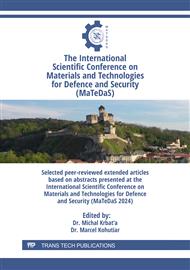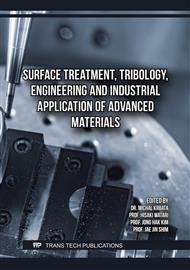[1]
C. Blankart, S. Wesselmecking, U. Krupp, Influence of quenching and partitioning parameters on phase transformations and mechanical properties of medium manganese steel for press-hardening application, Metals 11 (2021) 1879.
DOI: 10.3390/met11111879
Google Scholar
[2]
S. Kaar, D. Krizan, R. Schneider, C. Béal, C. Sommitsch, Effect of manganese on the structure-properties relationship of cold rolled AHSS treated by a quenching and partitioning process, Metals 9 (2019) 1122.
DOI: 10.3390/met9101122
Google Scholar
[3]
M. Krbata, D. Krizan, M. Eckert, S. Kaar, A. Dubec, R. Ciger, Austenite decomposition of a lean medium Mn steel suitable for quenching and partitioning process: comparison of CCT and DCCT diagram and their microstructural changes, Materials 15 (2022) 1753.
DOI: 10.3390/ma15051753
Google Scholar
[4]
J. Yan, M. Zhou, H. Wu, X. Liang, Z. Xing, H. Li, Z. Jiang, A review of key factors affecting the wear performance of medium manganese steels, Metals 13 (2023) 1152.
DOI: 10.3390/met13071152
Google Scholar
[5]
S. Mohapatra, G. Poojari, B. Satpathy, S. Das, K. Das, A comprehensive study on the effect of annealing temperature on the tensile and impact behavior of automotive-grade medium manganese steel (Fe-6.22 Mn-0.18 C), Journal of Materials Engineering and Performance 33 (2024) 5348-5363.
DOI: 10.1007/s11665-023-08861-x
Google Scholar
[6]
Z. Li, R. Wu, S. P. Song, Y. Wang, T. Wu, Influence of changes in alloying elements distribution and retained Austenite (RA) on mechanical properties of high boron alloy during quenching and partitioning (Q&P) process, Journal of Materials Research and Technology 18 (2022) 4748-4761.
DOI: 10.1016/j.jmrt.2022.04.124
Google Scholar
[7]
J. Lu, H. Yu, P. Kang, X. Duan, C. Song, Study of microstructure, mechanical properties and impact-abrasive wear behavior of medium-carbon steel treated by quenching and partitioning (Q&P) process, Wear 414 (2018) 21-30.
DOI: 10.1016/j.wear.2018.07.026
Google Scholar
[8]
G. Niu, D. Jin, Y. Wang, C. Gu, B. Ju, B. Ning, H. Wu, Effect of retained austenite on impact-abrasion wear performance of high-strength wear-resistant steel prepared by dynamic partitioning process, Wear 538 (2024) 205200.
DOI: 10.1016/j.wear.2023.205200
Google Scholar
[9]
X. Yan, J. Hu, L. Wang, Z. Chai, W. Sun, W. Xu, The coupled effect of thermal and mechanical stabilities of austenite on the wear resistance in a 0.2 C–5Mn-1.6 Si steel down to cryogenic temperatures, Wear 486 (2021) 204116.
DOI: 10.1016/j.wear.2021.204116
Google Scholar
[10]
D. K. Kim, H. J. Kim, S. Gong, S. E. Shin, S. J. Lee, A comparative study on the wear behavior of dual phase (DP) steel and quenching and partitioning (QP) steel, Tribology International 194 (2024) 109445.
DOI: 10.1016/j.triboint.2024.109445
Google Scholar
[11]
X. Yan, J. Hu, X. Zhang, W. Xu, Obtaining superior low-temperature wear resistance in Q&P-processed medium Mn steel with a low initial hardness, Tribology International 175 (2022) 107803.
DOI: 10.1016/j.triboint.2022.107803
Google Scholar
[12]
D. Kumar, I. Sen, T. K. Bandyopadhyay, A Systematic Review of Medium‐Mn Steels with an Assessment of Fatigue Behavior, steel research international 95 (2024) 2300375.
DOI: 10.1002/srin.202300375
Google Scholar
[13]
M. Krbaťa, I. Barényi, M. Eckert, D. Križan, S. Kaar, A. Breznická, Hot deformation analysis of lean medium-manganese 0.2 C3Mn1. 5Si steel suitable for quenching & partitioning process, Kovove Mater 59 (2021) 379-390.
DOI: 10.4149/km_2021_6_379
Google Scholar
[14]
H. Chen, X. Wang, R. Song, Y. Wang, W. Huo, Y. Zhang, S. Zhang, Microstructure, mechanical properties and strengthening mechanism of high strength hot-rolled ferrite-martensite dual phase steel, Materials Characterization 207 (2024) 113545.
DOI: 10.1016/j.matchar.2023.113545
Google Scholar
[15]
T. Kang, Z. Zhao, J. Liang, J. Guo, Y. Zhao, Effect of the austenitizing temperature on the microstructure evolution and mechanical properties of Q&P steel, Materials Science and Engineering: A 771 (2020) 138584.
DOI: 10.1016/j.msea.2019.138584
Google Scholar
[16]
M. Kohutiar, M. Krbata, J. Escherova, M. Eckert, P. Mikus, M. Jus, A. Dubec, The Influence of the Geometry of Movement during the Friction Process on the Change in the Tribological Properties of 30CrNiMo8 Steel in Contact with a G40 Steel Ball, Materials 17 (2023) 127.
DOI: 10.3390/ma17010127
Google Scholar
[17]
A. Fischer, K. Bobzin, Friction, wear and wear protection, John Wiley & Sons (2009).
Google Scholar
[18]
M. Sarıkaya, M. K. Gupta, I. Tomaz, D. Y. Pimenov, M. Kuntoğlu, N. Khanna, G. M. Krolczyk, A state-of-the-art review on tool wear and surface integrity characteristics in machining of superalloys, CIRP Journal of Manufacturing Science and Technology 35 (2021) 624-658.
DOI: 10.1016/j.cirpj.2021.08.005
Google Scholar
[19]
Y. Ji, S. Ma, W. Peng, Z. Cai, Research on alloy composition-process-wear properties of medium manganese steel based on machine learning, Tribology International 200 (2024) 110164.
DOI: 10.1016/j.triboint.2024.110164
Google Scholar
[20]
M. Krbata, M. Eckert, J. Majerik, I. Barenyi, Wear behaviour of high strength tool steel 90MnCrV8 in contact with Si3N4, Metals 10 (2020) 756.
DOI: 10.3390/met10060756
Google Scholar
[21]
Z. Cai, S. Wang, Y. Zhou, J. Dong, L. Ma, S. Liu, Influence of aging treatment on mechanical properties and wear resistance of medium manganese steel reinforced with Ti (C, N) particles, Friction 11 (2023) 2059-2072.
DOI: 10.1007/s40544-022-0712-8
Google Scholar
[22]
Z. Studeny, M. Krbata, D. Dobrocky, M. Eckert, R. Ciger, M. Kohutiar, P. Mikus, Analysis of Tribological Properties of Powdered Tool Steels M390 and M398 in Contact with Al2O3, Materials 15 (2022) 7562.
DOI: 10.3390/ma15217562
Google Scholar



